
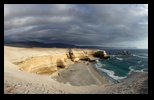

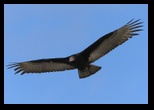



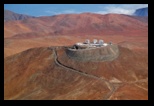
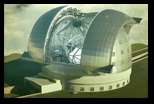
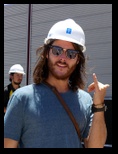
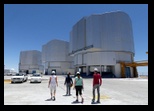
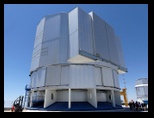
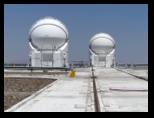


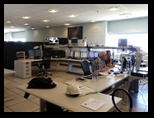
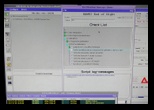
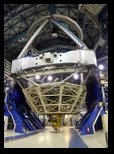
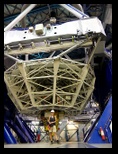
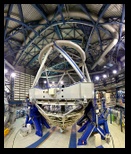
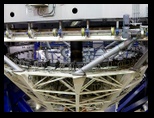

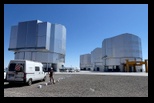
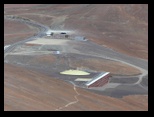

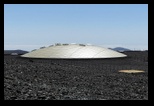

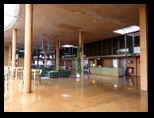
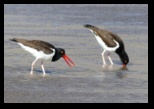
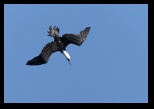
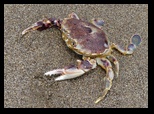
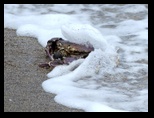
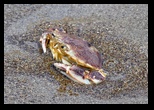

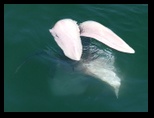
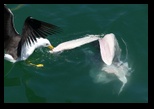
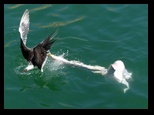
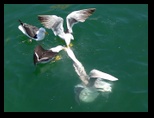
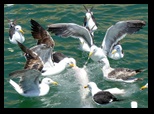

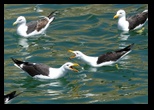
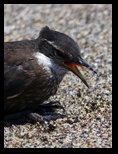
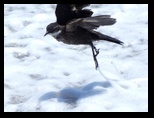

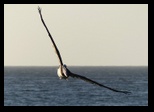
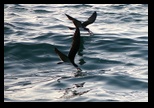
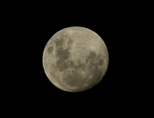
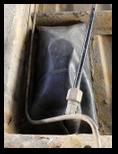
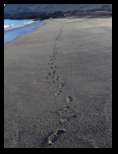

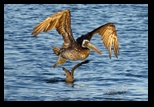
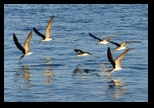
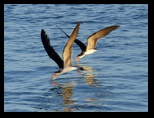
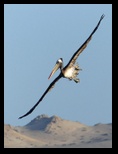
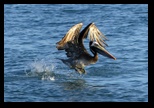
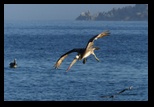
Click on a photo to enlarge it.
We got back to Taltal on Wednesday to get a print out of the ESO release form done. Without the form you cannot attend the free tour at the Paranal Observatory. I went to a small internet café to print them out and used one of the computers there. After printing I quickly checked our emails, since we couldn't find a free WiFi connection in town.
Unfortunately we got really bad news. Sadly Helen's dad passed away on January 13th. We were shocked and Helen needed to call her brother in England via Skype. The El Cafetal café had WiFi, but we needed the password for it. I explained the situation to the manager and she gave me the password without us needing to consume anything at the café. Thank you!
After Helen spoke to Mark we sat down to book flights via London and bus tickets to Keswick for Helen. It took a few hours. Helen was just about to phone Mark again when the internet connection was gone. I put Helen's booking reservations on a stick and went back to the internet café to print them out. But the shop lights and computers were all dark ... Taltal suffered a major power outage.
We decided to try again later and went to the local gas station to fill up and empty our toilet. An hour later the power outage was still on so we decided to head north towards Antofagasta. Helen's flight to Santiago de Chile was in two days. We didn't make it all the way. It was dark by the time we got to the Copec gas station in La Negra - an ugly industrial small town just south of Antofagasta. We spent the night there and had a shower the next morning. But there was no WiFi.
So we drove straight to a library in Antofagasta. The registration for our laptop to use with WiFi failed, so I had to use their computer. I sent Helen's email to Mark to let him know when Helen would be arriving in Keswick. There was a small copy shop near by and I managed to get printouts of Helen's bookings.
Since I will be on my own for the next 3.5 weeks, I needed to get some food shopping done. It was already 2pm by the time we got to the Jumbo supermarket in Antofagasta. We hadn't eaten anything all morning and were starving. So I quickly dashed in to buy us some bread rolls and pastries. Helen used the time to pack her bag for England while I did the main food shopping after our quick lunch. It was really hot in Antofagasta, more than 30°C in the shade. We were sweating buckets! Antofagasta is a very industrial town with a big port and it didn't feel really safe to us, so we never left Winnietwo on its own.
After the shopping was done, I went to fetch some more money and then we drove out north to a famous rock arch called La Portada. The airport is only 10km away from here, so we spent the night. Unfortunately some kids had to have a party on the large parking lot. On top of it, we were stressed out by the events and the change of plans and hardly got any sleep.
The alarm clock went off at 7.30am, Helens flight was at 11.10am. I dropped her off at the airport just after 9am and left Antofagasta afterwards. It's certainly not a city I wanted to spend 3.5 weeks in. Since we still had the booking at the Paranal Observatory, I decided to get back down south to attend the tour.
I haven't driven Winnietwo in a long, long time. Helen loves the driving and I love watching the scenery. W2 is a manual car, so I had to get used to using gears again. The route to Paranal was in the GPS, but it was still strange to drive on my own. After leaving the airport I took Highway 1 to Antofagasta. At a big roundabout I turned right to drive along the Ruta Costera (the costal route). Much easier than through the busy city centre.
All of a sudden I saw a police car with flashing lights behind me. As they always drive with the lights on here in South America, I didn't think they meant me, so I just continued. They pulled right next to me and beeped the horn. Oh, darn! One of the officers pointed to me to stop. Here? Right in the middle of heavy traffic? It's a four lane highway with no sidewalk or space to pull over. Shit! I put the emergency flashers on and stopped on the right lane. What now? What have I done?
Two officers were getting out of the police car. They approached me on the passenger side window. Licence, please! All our important papers are hidden in the back, so I had to climb through to get my passport and drivers licence. While one officer checked them and put notes into a small book, the other started asking me questions in Spanish. If I am on my own? I replied: Yes, normally we are two, but my friend had to go to England. When did I enter Chile? Ahhhhh ... I can't remember! Helen writes the daily diary, wears a watch, knows what day and month it is. I give a damn. For me every day is a Sunday. Thank God, I still had the little printout from the border in my hand with a stamp and the date on it. I read it to the officer, he seemed happy with the answer. Where did I cross the border? Ahhhh ... I can't remember the name of the bloody border crossing. Paso Agua Negra, I replied hesitantly. It was somewhere along that stretch.
The officers started smiling at me, handed me back my passport and licence and wished me a good day. That's it? What on earth did they stop me for? My heart is still racing, I am already totally stressed out and it hasn't been 10 minutes since I dropped Helen off!
I put everything back into its place and got going again. 5 minutes later I changed lanes for the next left turn. There was a long lorry parked on the right hand lane and the minute I was about to pass it, the driver pulled to the left and blocked my way. I was doing 40 miles an hour and had to break sharply to avoid hitting the lorry. The bowl with the dirty dishes went flying in the back. Crash, boom, bang! I could see the big eyes of the lorry driver and managed to break in time. But my heart rate was at 200, I was totally stressed out AGAIN! Thank God nobody hit me from behind! Helen, I miss you already!!!!
I was wondering, if this was maybe not a good day for me to drive and to pull over somewhere to get back into bed and forget about the rest of the day! Don't be a chicken, Kirsten ... keep moving! At least I managed to get out of Antofagasta without any further heart attack moments. Once I was on the Panamerican Highway the traffic was low, the road was straight and I didn't need to change gears all the time! I could finally relax again. Puh!
At around 11.45am I got to the turn off to the Paranal Observatory. The road went steeply up and I found a nice spot to park about a kilometre before the observatory. I desperately needed a soothing cup of tea!
I can already say at this point, that I'd never want to travel on my own. It's so much more relaxing with Helen. And I really missed her already. I felt very much alone. Pull yourself together, Kirsten! At least I had a really good and funny book to read and that cheered me up again.
I could see the four large telescopes from my parking spot. It was really quiet and peaceful up here! Late in the afternoon a car stopped in front of Winnietwo. The security people. Two very friendly men explained to me, that parking up here was not allowed. I needed to get back down to the main road and to find a spot there. I told them, that I am booked for tomorrows tour and that I don't feel safe all on my own down at the main road. I could tell, that they thought the same. I gave them our names and showed them the ESO release form. They promised to ask the boss at the observatory again and left.
Half an hour later they were back. Yes, I had a reservation at the tour but the boss still wanted me to park down at the main road. I pulled an unhappy face and one of them winked at me. "Oye!", he said in a nice slow Spanish, so I could understand every word "We are going down to the main road and then we come back. Should anybody else ask you to leave, just tell them you have engine problems and you have already spoken to us. We are checking this road all night long and we will keep an eye out for your safety. Comprende?" Ah, that was so sweet! Chileans are really nice people! I gave them a happy smile!
Shortly after sunset I was outside to watch the domes of the telescopes opening up for the night. A car pulled into the big parking space and a father and son got out to pitch a tent next to their car. We waved a friendly 'Hello' to each other and I was glad not to be on my own up here for the night. Normally that wouldn't have bothered me at all, but all on my own the fear level seems to be a lot higher. I miss my bodyguard!
There were a few light clouds around at sunset, but they vanished and the night was crystal clear. The milky way was twinkling brightly above me and Venus sparkled on the horizon. I was above 2000m in altitude and the Paranal Observatory is right at the centre of the milky way if you look straight up. No wonder, they built an observatory up here. 50% of the worlds largest observatories are situated in Chile. Why? 300 days a year there is a clear sky at night in the Atacama desert. The air is very dry, it hardly ever rains here and the wind blows steadily from the west. Within hundreds of kilometres there is no civilisation, hence no artificial light or pollution. Perfect conditions to observe the sky above us!
 Overnight spot at the Paranal Observatory - 360° Panorama
Overnight spot at the Paranal Observatory - 360° Panorama
(move mouse over panorama and click on the arrows)
There are two tours every Saturday. One at 10am and the other one at 2pm. I was on the latter one, so I had plenty of time in the morning to have breakfast, do the dishes and to relax. By 12.30pm more and more cars were coming up the road. Most of them stopped for a quick photo and then headed on to the observatory. Am I on the right time? Did we have a time change without noticing? I checked the computer and the GPS - both said it is 12.30pm. But I wasn't 100% sure and didn't want to miss the tour, so I packed up and drove to the gate. About 15 vehicles were already parked up just outside the gate for the tour.
I grabbed the release form to check myself in at the security gate, but had to come back to W2. I couldn't remember our licence plate ... I swear ... it's the altitude! ;-)
There was a German couple to attend the English tour and I helped Doris, who doesn't speak any Spanish to get checked in. Afterwards we had plenty of time to talk and she told me, that their car got broken into at a supermarket in Valparaiso. They had actually gotten a guy to keep an eye on the Mercedes Sprinter. By the time they got back one of the plastic windows in the back was broken and both cell phones plus food and other small items were gone ... including the guy, who was supposed to watch the car!
Siegmund, her husband, was talking to a young guy - Hawk from San Diego. Hawk hitchhiked to Paranal and he and the two Germans didn't apply for the tour online in advance. But there were only six people on the English guided tour, so it wasn't a problem for them to get in. A couple from Estonia joined our little group. The Spanish tour had more than 25 people or so.
On the dot at 2pm the gate to the observatory opened and we all jumped into our vehicles to drive through. I took Hawk on board with me. He drives a camper van in the USA, but didn't bring it down to South America. He instantly fell in love! Not with me, NO! - with Winnietwo!!! I had to smile! I know the feeling - Helen and I are in love with W2 too!
Our first stop was the Visitor Center. We got to see a 15 minute long video about all the ESO (European Southern Observatory) projects in Chile. ESO was founded in 1962 by five countries - Germany, Netherlands, Belgium, France and Sweden. Today there are 16 members, 15 of them from Europe (the five plus Austria, Czech Republic, Denmark, Finland, Poland, Portugal, Spain, Italy, Switzerland and the UK) and Brazil. Chile is not a member but gets certain privileges as the host country. ESO is a Non-Profit-Organisation. The ESO Headquarters are located in Garching, near Munich, Germany. This is the scientific, technical and administrative center of ESO where technical development programmes are carried out to provide the observatories with the most advanced instruments.
The European Southern Observatory (ESO) operates three unique world-class observing sites in the Atacama Desert region of Chile: La Silla, Paranal and Chajnantor. ESO's first site is at La Silla, a 2400 m high mountain 600 km north of Santiago de Chile. It has been an ESO stronghold since the 1960s and is equipped with several optical telescopes with mirror diameters of up to 3.6 metres. The 3.5-metre New Technology Telescope broke new ground for telescope engineering and design and was the first in the world to have a computer-controlled main mirror, a technology developed at ESO and now applied to most of the world's current large telescopes. The ESO 3.6-metre telescope is now home to the world's foremost extrasolar planet hunter: HARPS (High Accuracy Radial velocity Planet Searcher), a spectrograph with unrivalled precision. La Silla is still the second most scientifically productive in ground-based astronomy after the Paranal Observatory.
Paranal is situated about 130 km south of Antofagasta in Chile, 12 km inland from the Pacific coast in one of the driest areas in the world. Scientific operations began in 1999 and have resulted in many extremely successful research programmes.
The Very Large Telescope array (VLT) is the flagship facility for European visible-light astronomy. It is the world’s most advanced optical instrument, consisting of four Unit Telescopes with main mirrors 8.2 metres in diameter and four movable 1.8-metre Auxiliary Telescopes. The telescopes can work together to form the giant VLT Interferometer (VLTI) allowing astronomers to see details up to 25 times finer than with the individual telescopes. The light beams are combined in the VLTI using a complex system of mirrors in underground tunnels. With this kind of precision the VLTI can reconstruct images with an angular resolution of milliarcseconds, equivalent to distinguishing the two headlights of a car on the moon. The 8.2-metre Unit Telescopes can also be used individually to obtain images of celestial objects in one-hour exposures that are four billion times fainter than those visible to the naked eye.
The 8.2-metre telescopes are named Antu, Kueyen, Melipal and Yepun (Sun, Moon, Venus and Southern Cross) and are housed in compact, thermally controlled buildings, which are synchronised to rotate with the telescopes. The movable structure of each VLT Unit Telescopes inside the building is the azimuth platform and it weighs 430 tonnes, which is about the same as a fully loaded jumbo jet. However, it is so perfectly balanced and resting on hydrostatic oil-film bearings, that the giant telescopes can be moved by hand.
The first of the Unit Telescopes, Antu, began routine scientific operations on 1 April 1999. Since 2000 all four Unit Telescopes and all four Auxiliary Telescopes are operational. The VLT has stimulated a new age of discoveries, with several notable scientific firsts, including the first image of an exoplanet, tracking individual stars moving around the massive black hole at the centre of the Milky Way, and observing the afterglow of the furthest known gamma-ray burst.
Each year, about 2000 proposals are made for the use of ESO telescopes, requesting between four and six times more nights than are available. ESO is the most productive astronomical observatory in the world, which annually results in many peer-reviewed publications: in 2013 alone, over 840 refereed papers based on ESO data were published. Moreover, research articles based on VLT data are quoted twice as often as the average. The very high efficiency of the ESO's "science machines" now generates huge amounts of data at a very high rate. These are stored in a permanent Science Archive Facility at ESO headquarters. The archive now contains more than 1.5 million images or spectra with a total volume of about 65 terabytes (65,000,000,000,000 bytes) of data. This corresponds to the content of about 30 million books of 1000 pages each; they would occupy more than 1000 kilometres of bookshelves!
The Atacama Large Millimetre/submillimetre Array (ALMA), the largest ground-based astronomy project in existence, is a revolutionary facility for world astronomy. ALMA is comprised of an array of 66 giant 12-metre and 7-metre diameter antennas observing at millimetre and submillimetre wavelengths. ALMA started scientific observations in 2011 and was inaugurated in 2013. ALMA is located on the high altitude Chajnantor Plateau, at 5000m elevation — one of the highest astronomical observatory sites in the world. ALMA is a partnership of ESO (representing its Member States), NSF (USA) and NINS (Japan), together with NRC (Canada), NSC and ASIAA (Taiwan), and KASI (South Korea), in cooperation with the Republic of Chile. The Chajnantor site is also home to the 12-metre APEX millimetre and submillimetre telescope, operated by ESO. Submillimetre astronomy opens a window into the cold, dusty and distant Universe. It cannot be seen in the visible or infrared light. Light at these wavelengths shines from vast cold clouds in interstellar space, at temperatures only a few tens of degrees above absolute zero (a frigid -272.85°C!). Astronomers use this light to study the chemical and physical conditions in these molecular clouds - the dense regions of gas and cosmic dust where new stars are being born. This wavelength is also ideal for studying some of the earliest and most distant galaxies in the Universe.
The next step beyond the VLT is to build the European Extremely Large optical/infrared Telescope (E-ELT) with a 39-metre primary mirror.The E-ELT will be "the world's biggest eye on the sky" — the largest optical/near-infrared telescope in the world and will address many of the most pressing unsolved questions in astronomy. It may, eventually, revolutionise our perception of the Universe. It is built on Cerro Armazones - a peak in the Chilean Atacama Desert, with an altitude slightly above 3000 metres roughly 20km away from Cerro Paranal. Construction of the road and platform started in early 2014, with first light planned for 2024. The construction cost of the full baseline E-ELT is estimated to be 1083 million Euros (2012 prices). The E-ELT will be operated as an integral part with the existing ESO Paranal Observatory. The operating cost includes not only the cost of running the observatory in Chile, but also the cost of operation support in Garching as well as re-investment costs for telescope upgrades and new instruments/cameras for the telescope. The total operating cost is estimated to be 50 million Euros per year. The current operation plan foresees that the E-ELT will be used for at least 30 years.
The European Extremely Large Telescope (E-ELT) will have a 39-metre mirror (almost half the length of a soccer pitch) and will thus be the biggest telescope in the world - by far - to observe in the visible and the near-infrared (there are larger radio telescopes). The current largest optical telescopes have diameters of up to ten metres, and the E-ELT's diameter will thus be four times greater.
The 39m primary mirror will be composed of about 1000 hexagonal segments, each about 1.45m from corner to corner. Each segment will be about 50mm thick and weighs 165kg. The E-ELT alone will gather more light than all of the existing 8–10-metre class telescopes on the planet combined, and 100 million times more light than the human eye, and will be able to detect objects millions of millions of times fainter. It will also provide images 15 times sharper than those from the Hubble Space Telescope. This diameter was chosen because it is the minimum diameter needed to achieve some of the driving science cases: to image rocky exoplanets to characterise their atmospheres (VLT can only indirectly detect such Earth-like planets), and to measure the acceleration of the expansion of the Universe directly.
The video is in English with Spanish subtitles. Hawk and I were extremely impressed. Amazing what mankind can do! We couldn't wait to get onto the tour, but the only toilets for the tour are at the Visitor Center and since the tour is at least 2 hours long, one can imagine the queue. Thank God, we were only a really small group. We got kitted out with a safety helmet (very sexy!) and then jumped back into the vehicles to drive up to the platform with the four giant telescopes.
 Paranal platform with the four giant telescopes - 360° Panorama
Paranal platform with the four giant telescopes - 360° Panorama
(move mouse over panorama and click on the arrows)
Our tour guide was a young woman from Antofagasta. She studies Chemistry at the observatory and at the university of Antofagasta. Her English was fluent but a little hard to understand. She gave us a lot of information during the tour and I will try to write down as much as I remember in this report. Hawk and I were the only ones asking questions, the German couple struggled to understand her English and I tried to translate as much as possible, the couple from Estonia didn't say a word. Hawk and I had a ball!
We left the vehicles on the parking lot right next to one of the giant telescopes. The enclosures of the VLT Unit Telescopes are 25 metres high, about the same as an eight-floor building. W2 looked really small and the telescopes were towering above our heads. The domes are closed during the day, because they can't detect anything in the bright daylight. During the night all vehicles have to turn off their headlights to keep it really dark up here. The Chilean Government gave a guarantee to ESO that there will be no urban development within a 100km radius.
Interestingly the grounds of the observatory are European territory and the cars have blue licence plates. Chile donated or sold the land to ESO (nobody wants to really tell the truth about this issue!) which operates under European law. The only stipulations were that a minimum of 50% of employees at Paranal are from Chile - such as security, gardeners, kitchen and cleaning staff for the hotel, drivers etc. In addition to that astronomers and scientists from Chile get a 10% access to the telescopes or direct access to public data generated at Paranal for their own studies. All employees at Paranal work for 8 days in a row and then they get 6 days off. Why? It is so dry up here, that it could cause harm to the human body. Most of them spend their time off in Santiago de Chile.
Paranal cannot observe 100% of the Universe, only the sky above the southern hemisphere is visible to the telescopes. Large telescopes in the USA (Texas, Nevada, Arizona) watch the sky above the northern hemisphere. Data is often exchanged between the nations. We do have observatories in Europe, but only with very small telescopes. Europe is not a good place to build something like Paranal. The weather is too unpredictable and the density of population too big, hence there is too much artificial light and pollution.
Energy production is one of the most difficult parts when setting up a remote operation away from the electrical grid. At Paranal they use diesel generators. When we drove past the La Silla Observatory site a few weeks ago, we saw the large fields of solar panels and the Paranal tour guide confirmed that the solar panels have produced most of the energy for La Silla since 2016.
The Paranal platform production costs were around 500 Million US Dollar. Each second the telescopes are in operation costs 1 EURO. That includes the costs for power, air conditioning, computers, maintenance and so on. I just had to get a calculator out ... Wow! ... 60 seconds x 60 minutes x 24 hours ... that's a total of 86.400 EUROS per day!!! Later on I read on the ESO website that Germany contributes 22.4% to the yearly total budget (156.443.000 Euro for 2016), so around 35 Million EUROS. The UK contributes 18.6%. That's a lot of money for a Non-Profit-Organisation. I wonder where all the money comes from - most likely tax money, but it is well spent.
How thick the concrete for the platform is, I wanted to know, but our tour guide didn't know. We are after all in an earthquake territory. The VLT is designed with anti-seismic technology, specially chosen to protect the most delicate components of the telescopes. If there is a strong earthquake (more than magnitude 7) a special system is automatically activated, anchoring the primary mirror to the cell. This prevents it from falling, breaking, or causing damage to the structure.
All telescopes on the platform are directly connected to the control center, which is also situated on the platform. The telescopes are directed from here and all data from the telescopes runs back to the control center. Each telescope takes one picture per second at night. The exposure times are between 30 seconds and one hour, depending on how far away the object is from earth and how much light it emanates.
 Great view from Cerro Paranal onto the coast of Chile - 360° Panorama
Great view from Cerro Paranal onto the coast of Chile - 360° Panorama
(move mouse over panorama and click on the arrows)
After taking photos on the platform we went straight into the control center. During the day not a lot of people are working here, but it's very busy during the night. Each telescope has its own section in the control center, which is supervised and operated by an ESO telescope operator. The astronomer works right along with the operator.
At present, most observations are done in service mode (meaning the astronomer works from a computer away from Paranal), at 60-70% of the total time, versus 30-40% for the visitor mode. Although the VLT is exclusively operated by highly specialised ESO staff, the visitor mode offers astronomers the opportunity for direct interaction, which is particularly useful whenever any real-time decision is needed.
Any scientist or astronomer in the world can apply for the use of any of the ESO telescopes. A proposal of the project has to be sent in a year in advance (May and October are the proposal time slots) to the ESO headquarters in Garching (Germany). A decision board in Germany will rate the project and only the best ones will get a time slot for the use of the telescopes.
When a project is approved by ESO, the astronomer gets everything for free - use of telescopes and computers, as well as accommodation and food at Paranal. Should weather or a technical failure of the telescope not permit the allotted observation time, the astronomer will lose it. The schedule for the use of the telescope is so tight and is planned a year in advance, that is is not flexible for changes.
All ESO projects are confidential. The data from the telescopes belongs to the astronomer for one year, then it is released to the public. That gives the astronomer time to write his paper. You never know, he or she might get a Nobel prize one day for it. The astronomer leaves Paranal with just a USB stick or an external hard drive.
It takes half an hour to get each of the four large telescopes ready for operation. The coordinates for the object, that is to be observed, are put into the computer at the control center. Then the domes open up. One of the telescopes (Yepun, Unit Telescope 4) is equipped with a laser beam. The laser guide star is part of the VLT´s adaptive optics system and a half a metre wide beam is launched into the Earth's atmosphere to measure its thickness, density and the turbulences which are different every night. The measurement determinates the use of certain computerized filters for the telescopes. Our atmosphere deflects the light rays which causes distorted images. The filters correct that into much clearer images. Yepun typically observes with the laser guide star for about 25% of the time. It is used for adaptive optics when no good reference stars are found in the field of view.
Hawk, my new friend from San Diego, discovers, that one of the software programs is called Hawk1. What does it do? ... something to do with calibration. Hawk immediately wants a job here at Paranal. :-)
Our last stop on the platform is Antu, the first telescope that went into operation in 1999. We entered the building through a 5cm thick steel door. Our first impression ... WOW! The sound alone was impressive! A humming, that made us feel as if we were in an alien spaceship. Hollywood at its best!
It was pretty cold inside, around 13°C. Electrical parts of the telescope are cooled down with liquid helium and liquid nitrogen to prevent overheating. Both liquids are produced on site at Paranal. The temperature inside the telescope building equals the average outside night temperature. Why? When the dome opens at night, the temperature and the air pressure has to be the same inside as it is outside to prevent condensation and humidity. Both would cause blurring of the images. It's the same effect as fogged up glasses.
We looked like gnomes next to the telescope. Hawk took a few photos of me and vice versa. I had to take panorama shots to get the whole telescope into the picture. We were even allowed to go onto the balcony to get a direct view onto the 8.2m large mirror. I thought it would be much more concave, it looked almost flat.
The VLT mirrors are only 17.5 cm thick – very thin relative to their size. If you scaled a mirror down to the size of a CD, its thickness would be equivalent to just two discs placed on top of each other. Despite being very thin, the large diameter means the glass weighs 23 tonnes.
The VLT primary mirrors are made out of glass and ceramic with almost no thermal expansion, called Zerodur, which has an opaque-beige appearance. It was produced in Germany by a company called Schott, which went bankrupt a number of years ago. It took three years to build the glass and ceramic base of the mirrors. Afterwards they were sent to France and were polished there for a year. The reflective surface is a layer of aluminium only 80 nanometres thick. If we were to scale the mirror to the diameter of the Earth, this aluminium layer would still be only 12 cm thick. The amount of aluminium needed to coat a single VLT primary mirror is about 12 grams, which is less than the amount in a soft drink can. The total production costs per mirror were 2 million EUROS. One actually broke during the transport to Chile and a new one was built.
An optical surface needs to be very accurately polished so that its imperfections are smaller than the wavelength of the collected light. Otherwise, the image will be degraded. In the case of the VLT, if we scale the diameter of the 8.2-metre primary mirrors to the size of the Earth, the largest imperfection on them would still be no larger than a pebble.
As the telescopes are open to the sky during the whole night, the mirrors accumulate dust on their surface, losing reflectivity. They therefore need to be cleaned from time to time. Once a month the mirror is put at an almost 90° angle and then covered from top to bottom with a CO2 foam. The foam runs down the mirror and takes all dust particles off without scratching the aluminium layer. Every 18 months the mirror is completely taken out of the building. A crane, that is attached to the side of the building, lifts it onto a truck bed. It is then brought down the mountain to one of the maintenance buildings where the old aluminium layer is removed by chemical washing and then recoated. The whole process takes about a week.
Repairs are done with utmost diligence. Everything above the mirror, personnel and all tools, are hooked into a safety line. Sometimes even a safety net is used, so nothing drops onto the mirror and breaks it. During the night nobody is allowed inside the telescope buildings unless there is a technical problem that needs to be fixed.
How does the telescope work? Light from space falls onto the 8.2 primary mirror. From there it gets reflected to the secondary mirror which sits on top of the telescope. The diameter of this mirror is only 1.24m, so about an eighth of the main mirror. From there the light gets reflected to a third mirror (diameter 0.94m) which sits between the two other mirrors. The last mirror directs the light into the computers where the images are taken. The secondary mirror is actually the most important one, it vibrates and uses adaptive optics to avoid distortion.
I asked our tour guide if the scientists actually believe in life outside our planet. Her answer: Yes and No. They don't believe that there are civilisations like us - intelligent beings. But they suspect that there is definitely life out there in the form of bacteria, unicellular organisms etc.
I personally find the whole concept of the expanding universe and the building of stars and planets very hard to comprehend. It is way above my intelligence and imagination. I think it would be a disaster if we are the only intelligent beings in the whole universe. We are doing our very best to destroy this planet. And if there is nothing else out there, that resembles this planet ... hopefully we never get to the point of totally destroying our planet Earth!
It brings my hackles up when I see how much garbage is just thrown onto the beaches, into the sea and out on the street here in Chile and Argentina alone. A visit to Paranal should be mandatory for the population here. Maybe then they will realise how special our planet is!
After a few more photos we got back into the vehicles and drove down to the Paranal Hotel. The Residencia is an award-winning building, and served as a backdrop for part of the James Bond movie Quantum of Solace.
The atrium is under a glass dome, which is covered during the night, so the artificial light does not affect the observations. There is a swimmingpool, a garden, the lobby and the dining room and kitchen in the atrium. The hotel complex with 108 rooms is in a side wing facing away from the telescopes. The hotel is where all the employees and astronomers stay while at Paranal. Nobody else is allowed to stay, so don't bother trying to book a room!
This was the end of the tour. We went back to the Visitor Center to drop off the safety helmets. Hawk got a lift with the couple from Estonia back to Antofagasta, where he left all his stuff in a backpackers.
Impressive free tour of the Paranal Observatory.
There is a lot more information on the ESO website. Check it out!
By the time I left Paranal it was around 5.30pm. I still had just about enough time to get to the beach at Taltal before the sun was down. I spent a relaxing Sunday there and then went into town on Monday to empty the toilet, do some food shopping and getting online to phone Helen in England. She got to England just fine and was already busy organizing the funeral and paper work.
At the Copec gas station I met a young couple, that was travelling in a van. Juan is from Argentina and his girlfriend Sylvia from Italy. They were on their way south and didn't have any proper maps or GPS information. So I got talking to them and suggested they drive to Playa Cifuncho in the afternoon - my next destination as well.
The two invited me that night for a BBQ. The potatoes boiled really fast on the fire but the chicken took forever. But it was yummy. I joined in with a bar of chocolate for dessert and a BBQ sauce for the chicken. Above us the stars were amazing and I learned the Spanish word for Milky Way - la Vía Láctea.
Both of them didn't speak much English so we talked in Spanish the whole time. A little exhausting for me, but they were very patient with me and talked slowly, so I could understand most of the conversation. They met in Mexico a number of years ago. They travel and work whenever they need money.
They stayed for two nights and then went further south. Have a safe trip, amigos!
Cifuncho was the perfect place for me to wait for Helen. Safe and quiet and there was always something to see. I was usually surrounded by Chilean campers who set up their tents for a few days. I spent the days working on the computer, reading, walking on the beach, cooking and got a lot of sleep as well. But I missed Helen a lot! Nobody there to make me laugh!
I usually don't have a problem to be by myself, but for some reason there was always an uneasy feeling in my gut. Up in Canada I am usually so busy and the time is flying by when Helen does her own thing from time to time. But here I had a lot of time to think. And for some reason you start thinking about worst case scenarios all the time. Is there an earthquake somewhere near by and will I notice the warning bells when there is a tsunami? Will I have a flat tyre on my way into Taltal or on the way back to Cifuncho? Nobody knows where I am if something seriously happens to me ... things like that. I think it has something to do with getting older. For some reason I am getting more fearful. Stupid! But we cannot change our feelings, can we?
I also think, that I've never been this quiet for such a long time in my whole life! Lots of days I had nobody to talk to. This is very unusual for me. Just to hear my own voice I put on music to sing along! Helen would have been very annoyed about that, if she would have been here. I don't know why ... I CAN sing! At least I think so! ;-)
We inherited a stereo system from Steffen and his family but have actually never used it. Helen prefers driving without any radio or music on and I put on my mp3 if I need to listen to some music. Well, now was the time to try it out! I got the instructions out, plugged the radio and my mp3 in and turned up the sound. Whoa! Great sound in the back! In the front the right loud speaker is distorted and the sound is not as good as it is in the back. I think we should use it more often in the future! Maybe I should put some of Helens music on the mp3 ... otherwise, Madame will not want to listen to it and it's getting banned again. Sigh!
But having some down time was good for me too. I could fully concentrate on the computer work and finally managed to collect all the GPS data of what we have done so far in South America. So, whoever is interested in where we stayed for the night, where we found the facilities we needed and what we highly reccommend to see and do can now download a Garmin (just click on the blue button) or GPX file (right click -> save as ...) from each of our reports. All explanations are in English. I also wrote the latest reports including the English ones, so Helen doesn't have to do them when she comes back from England. (Note from Helen - thanks so much for writing the English reports. Just checking through them took me two hours! It would have taken me days to write!)
There were also some improvements and repairs to be done for Winnietwo. I went underneath to fix the tiny leak that we still had in our diesel tank. Hopefully, this time I managed to cover it all up. Steffen left us a large tyre innertube that I used to cover the outlet of the heater underneath Winnietwo. The cover needed to be flexible for putting it on and taking it off when we have the heater running. So I used velcro strips and attached them with epoxy to the outside rim of the outlet and the inside of the rubber, that I cut to the precise size (see photo above). Hopefully this will help a great deal to prevent all the dust from coming in when we drive on gravel roads. We tried to cover the heater up from the inside with a piece of foam and a wet towel but that never worked 100%. I was very pleased with my new cover and it was still tightly on after my next drive to Taltal. I also cleaned and covered some rusty parts. Now all that's left to do is something to cover the backdoors, so the dust from the gravel roads can't get in that way. I have a good idea but I don't have any velcro left and we can't find any adhesive velcro here in Chile. We have to buy that in Canada next time and bring it down.
Every Sunday I drove to Taltal which is about 45km north of Cifuncho to empty the toilet, do the shopping and phone Helen and my mum (yep, mother was of course concerned about me being all on my own!).
All in all the 3.5 weeks went by really fast. I kept myself busy. Helen wanted me do to a detailed planning for the next few months of travelling. I didn't have time for it! I can hear Helen already and see her rolling her eyes ... What have you done all this time I was gone? Well, if you have to do everything on your own it takes twice as long. But I'll be very glad when you are back!!!
By the way, I managed to get us another tour reservation for the Paranal Observatory - Helen shouldn't miss out on it and it's only 150km south of Antofagasta. More about this in the next report, which will be written by Helen again. Hope, you enjoyed my contribution. It was fun writing it!